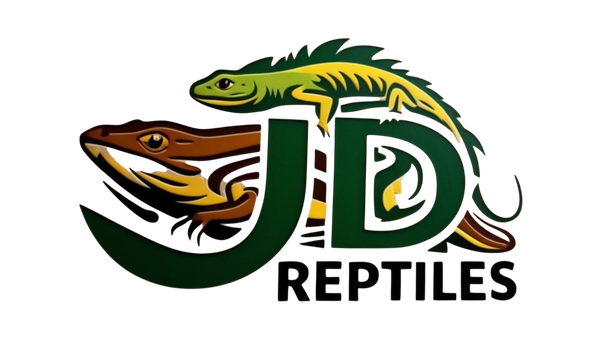Bearded Dragon Care Sheet

Scientific Name: Pogona vitticeps
Common Names: Bearded Dragon, Beardie
Origin: Native to arid and semi-arid regions of Australia
Average Size: 18-24 inches (45-61 cm)
Lifespan: 8-12 years in captivity
Overview
Bearded dragons are one of the most popular pet reptiles due to their calm temperament, unique appearance, and interactive nature. Known for their “beard” display and friendly personalities, beardies make great companions for both beginner and experienced reptile keepers. They are diurnal, meaning they are active during the day, and enjoy human interaction when properly socialized.
Housing Requirements
Enclosure Size
Juvenile Bearded Dragons (under 10 inches): Minimum 20-gallon tank
Adult Bearded Dragons: Minimum 40-gallon tank, but larger enclosures (75-120 gallons) are strongly recommended for full-grown adults.
Bearded dragons are ground-dwelling but enjoy climbing on branches and rocks. A spacious, well-ventilated glass terrarium or reptile-specific enclosure works best.
Enclosure Setup
Substrate: Use safe substrates such as reptile carpet, paper towels, or tile. Loose substrates like sand can pose an impaction risk, especially for juveniles.
Hides & Climbing: Provide at least two hides (one on the warm side and one on the cool side) along with branches, rocks, and basking platforms for climbing and enrichment.
Water: Provide a shallow water dish for drinking and occasional soaking. Mist vegetables and offer occasional baths to help with hydration.
Temperature & Humidity
Temperature Gradient:
*Basking Spot: 95-110°F (35-43°C)
*Cool Side: 75-85°F (24-29°C)
*Nighttime Temperature: 65-75°F (18-24°C)
Humidity: Maintain low to moderate humidity levels around 30-40%. Ensure good airflow to prevent respiratory issues.
Use a basking bulb and a UVB light to replicate natural sunlight. UVB lighting is crucial for vitamin D3 production and calcium absorption.
Feeding
-Diet: Bearded dragons are omnivores. They require a balanced diet of live insects and fresh vegetables. Juveniles need more protein, while adults need more greens. Recommended foods include:
Insects:
*Crickets
*Dubia roaches
*Black soldier fly larvae
*Mealworms or superworms (as occasional treats)
Greens & Veggies:
*Collard greens
*Mustard greens
*Turnip greens
*Dandelion greens
*Squash, bell peppers, carrots (in moderation)
Fruits: Offer sparingly—berries, mango, or melon can be given occasionally.
-Feeding Frequency:
Juvenile Dragons: Feed insects daily and offer fresh greens daily.
Adult Dragons: Feed insects 2-3 times per week and offer fresh greens daily.
-Prey Size: Offer insects no larger than the space between your dragon’s eyes to avoid choking or impaction.
-Supplements: Dust insects with calcium powder (without D3 if UVB is provided) 4-5 times a week and use a multivitamin once a week.
-Water: Always provide fresh water daily. Some beardies prefer to drink from misted vegetables or shallow baths.
Shedding
Shedding Process: Bearded dragons shed their skin in patches, especially around the limbs and tail. Young dragons shed more frequently due to rapid growth.
Signs of Shedding: Dull, whitish skin indicates shedding is near. You may notice your dragon rubbing against objects to help remove old skin.
Humidity for Shedding: Ensure proper hydration and provide occasional baths to help with shedding. Never peel off stuck shed forcefully.
Handling
Temperament: Bearded dragons are known for their docile, friendly nature. They tolerate handling well and often enjoy interacting with their owners.
Handling Frequency: Handle your dragon regularly to build trust and maintain socialization. Avoid handling during shedding or right after feeding.
Safety: Always support your dragon’s body, especially its belly and limbs. Sit on the floor when handling young dragons to prevent accidental falls.
Health & Veterinary Care
Common Health Issues:
*Metabolic Bone Disease (from lack of UVB or calcium)
*Impaction (from eating substrate or oversized prey)
*Parasites (internal and external)
*Respiratory infections (from incorrect temperatures or high humidity)
Routine Checkups: Schedule annual checkups with a reptile-experienced veterinarian. Routine fecal exams help detect parasites early.
Signs of Illness: Lethargy, lack of appetite, sunken eyes, difficulty shedding, or abnormal stools may indicate illness. Seek veterinary care if you notice these signs.
Signs of Stress: Dark stress marks on the belly or chin, glass surfing, or loss of appetite may signal stress. Check your habitat conditions and handling routine.
Breeding Information
Sexing: Males have larger femoral pores on the underside of their thighs and a broader head. They also display more prominent hemipenal bulges at the base of the tail.
Breeding Season: Breeding generally occurs in spring and summer. Provide proper brumation (cooling period) beforehand if you plan to breed.
Egg-Laying: Females lay clutches of 15-30 eggs. Provide a nesting box with moist soil or vermiculite for egg-laying. Incubate eggs at around 82-86°F (28-30°C) with high humidity. Incubation takes about 55-75 days.
Conclusion
Bearded dragons are excellent pets for reptile enthusiasts of all experience levels. With their friendly demeanor, engaging behavior, and manageable care needs, they bring joy and fascination to any keeper. With proper housing, a balanced diet, and regular care, your bearded dragon can live a long, healthy, and happy life.
Note: Before bringing home a bearded dragon, make sure you’re prepared for the responsibility of proper habitat setup, daily feeding, and regular health care. A well-cared-for bearded dragon will reward you with years of companionship and curiosity.
